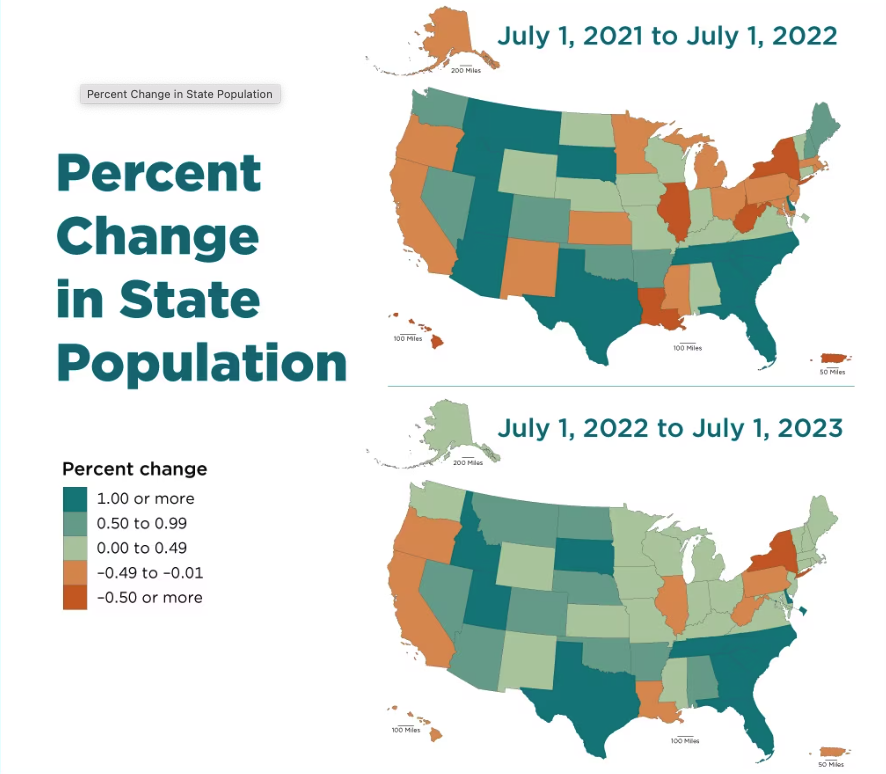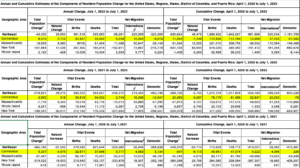The U.S. Census Bureau unveiled state-specific statistics last month for the years 2022 and 2023, revealing that from July 1, 2022, to July 1, 2023, Connecticut experienced a rise in its total population of 8,470.
During this timeframe, the state experienced a net inbound migration increase of 6,248 fueled by 15,264 from international migration, counteracting the 9,016 individuals who moved out of the state. According to the U.S. Census Bureau, population estimates encompass all immigration regardless of legal status.
Additionally, the state’s population growth was boosted by 2,115 more births than deaths, further offsetting the decline in domestic migration.
This marks the second consecutive year where overseas migration has played a pivotal role in driving positive population growth. In the 2021-2022 report, 16,296 individuals arrived through international migration, while 13,547 left the Constitution State. During this period, births outpaced deaths by 916 resulting in a positive total population change of 2,850.
Furthermore, according to the U.S. Census Bureau, the cumulative change in population from April 1, 2020, to July 1, 2023, shows that Connecticut witnessed a total population surge of 11,264. Once again, foreign migration played a key role in this positive trend with 37,453 individuals arriving from outside the United States, while 21,485 residents moved out of the state. It is noteworthy that there were 1,248 more deaths than births during this period which can partially be attributed to the impact of the COVID-19 pandemic.
Neighboring states Massachusetts and Rhode Island exhibited comparable demographic trends. Although both states saw an overall population increase from 2022 to 2023, the growth was predominantly attributed to international migration. Massachusetts witnessed a net gain of 18,659 individuals, with 50,647 arriving through international migration, yet experiencing a loss of 39,149 domestically. Similarly, Rhode Island recorded a net gain of 2,210 with 5,777 from international migration and a domestic loss of 3,224.
Notably, over the three-year period from 2020 to 2023, Massachusetts faced an overall population decrease, with 31,534 residents leaving the Bay State. In Rhode Island, during the same timeframe, 1,409 individuals departed the state.
New York experienced a significant population decline, shedding 101,984 residents, marking it as the state with the largest population loss in the country over the 12-month period. This continues a three-year trend for the Empire State, with a total loss of 631,104 residents, although there are signs of a slowdown this year. In 2022, the state lost 180,341 residents, and in 2021, the loss amounted to 319,020. Once again, international migration outpaced domestic with 73,867 immigrants arriving while 216,778 individuals left. Despite the influx, it wasn’t sufficient to offset the overall population decline as it did in Connecticut.
A similar pattern unfolded in the Northeast, losing 43,330 residents to other states. Over the past three years, the region has witnessed a loss of 630,624 individuals, with this year’s decrease showing a less severe trend compared to the previous two years — 218,851 (2022 estimates) and 365,795 (2021) estimates.
While the Northeast grapples with population decline, the South is experiencing a surge, solidifying its status as the nation’s most populous region. In 2023, the South contributed significantly to the country’s growth, accounting for 87% or roughly 1.4 million of the total population change in the United States — approximately 1.6 million. Notably, the South stands out as the sole region to sustain population growth consistently throughout the COVID-19 pandemic. The region’s growth was propelled by a substantial increase in domestic migration, with 706,266 individuals added, alongside 499,880 from overseas migrants.
The data suggests an ongoing trend where residents are opting to relocate to states with lower tax rates as opposed to those with higher tax burdens. According to a report from the Tax Foundation on Jan. 9, these population shifts clearly indicate that Americans are choosing to leave high-tax and high-cost-of-living states in favor of alternatives with lower tax burdens. The report highlights that among the 32 states where overall state and local tax burdens per capita were below the national average in 2022, 24 witnessed a net inbound migration in 2023. Conversely, of the 18 states and D.C. — including Connecticut — with tax burdens per capita at or above the national average, 14 experienced net outbound migration.
As the General Assembly reconvenes on Feb. 7, lawmakers must acknowledge that the pandemic has made it easier for people to move — evident in the recent U.S. Census Bureau data. Amidst the clamoring for increasing the spending and borrowing caps by the State Employee Bargaining Agent Coalition (SEBAC) and calls from legislators advocating for higher taxes on the wealthy, lawmakers need to redirect their focus towards enhancing the state’s competitive edge. It is crucial for them to take note of the patterns in people’s relocations and consider strategies that improve the state’s overall attractiveness.


